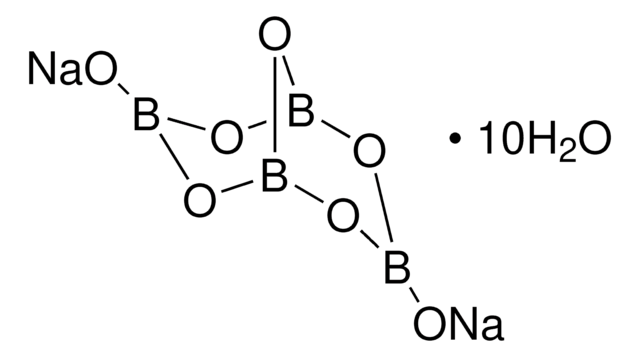15663
Borsäure
BioUltra, for molecular biology, ≥99.5% (T)
About This Item
Empfohlene Produkte
Qualität
for molecular biology
Qualitätsniveau
Dampfdruck
2.6 mmHg ( 20 °C)
Produktlinie
BioUltra
Assay
≥99.5% (T)
Form
powder or crystals
Methode(n)
DNA purification: suitable
RNA purification: suitable
Verunreinigungen
DNases, none detected
RNases, none detected
insoluble matter, passes filter test
phosphatases, none detected
proteases, none detected
<0.05% non-volatile substances in MeOH/HCl
Verlust
≤0.5% loss on drying, 20 °C (HV)
pH-Wert
3.6-4.4 (25 °C, saturated solution in H2O)
mp (Schmelzpunkt)
160 °C (dec.) (lit.)
Löslichkeit
H2O: 1 M, clear, colorless (hot)
Dichte
1.49 g/cm3 at 23 °C
Anionenspuren
chloride (Cl-): ≤5 mg/kg
phosphate (PO43-): ≤5 mg/kg
sulfate (SO42-): ≤5 mg/kg
Kationenspuren
Al: ≤5 mg/kg
As: ≤0.5 mg/kg
Ba: ≤5 mg/kg
Bi: ≤5 mg/kg
Ca: ≤10 mg/kg
Cd: ≤5 mg/kg
Co: ≤5 mg/kg
Cr: ≤5 mg/kg
Cu: ≤5 mg/kg
Fe: ≤5 mg/kg
K: ≤50 mg/kg
Li: ≤5 mg/kg
Mg: ≤5 mg/kg
Mn: ≤5 mg/kg
Mo: ≤5 mg/kg
Na: ≤50 mg/kg
Ni: ≤5 mg/kg
Pb: ≤5 mg/kg
Sr: ≤5 mg/kg
Zn: ≤5 mg/kg
SMILES String
OB(O)O
λ
1 M in H2O
UV-Absorption
λ: 260 nm Amax: 0.015
λ: 280 nm Amax: 0.010
InChI
1S/BH3O3/c2-1(3)4/h2-4H
InChIKey
KGBXLFKZBHKPEV-UHFFFAOYSA-N
Suchen Sie nach ähnlichen Produkten? Aufrufen Leitfaden zum Produktvergleich
Anwendung
Sonstige Hinweise
Signalwort
Danger
H-Sätze
Gefahreneinstufungen
Repr. 1B
Lagerklassenschlüssel
6.1D - Non-combustible acute toxic Cat.3 / toxic hazardous materials or hazardous materials causing chronic effects
WGK
WGK 1
Flammpunkt (°F)
Not applicable
Flammpunkt (°C)
Not applicable
Persönliche Schutzausrüstung
Eyeshields, Gloves, type P3 (EN 143) respirator cartridges
Analysenzertifikate (COA)
Suchen Sie nach Analysenzertifikate (COA), indem Sie die Lot-/Chargennummer des Produkts eingeben. Lot- und Chargennummern sind auf dem Produktetikett hinter den Wörtern ‘Lot’ oder ‘Batch’ (Lot oder Charge) zu finden.
Besitzen Sie dieses Produkt bereits?
In der Dokumentenbibliothek finden Sie die Dokumentation zu den Produkten, die Sie kürzlich erworben haben.
Kunden haben sich ebenfalls angesehen
Unser Team von Wissenschaftlern verfügt über Erfahrung in allen Forschungsbereichen einschließlich Life Science, Materialwissenschaften, chemischer Synthese, Chromatographie, Analytik und vielen mehr..
Setzen Sie sich mit dem technischen Dienst in Verbindung.







